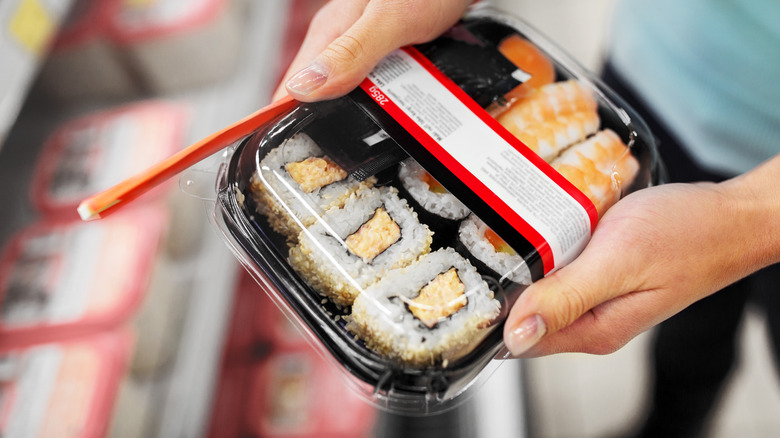Sushi is a popular Japanese dish that is enjoyed all over the world. However, sushi is also a delicate food that requires proper storage to maintain its freshness and flavor. In this article, we will discuss the best ways to store sushi to ensure it stays delicious and safe to eat.
1. Keep it Refrigerated

Sushi is best stored in the refrigerator to keep it fresh. If you have leftover sushi, wrap it tightly in plastic wrap or put it in an airtight container before placing it in the fridge. Make sure to consume the sushi within 24 hours of refrigeration to avoid any potential foodborne illnesses.
2. Don’t Freeze Sushi
While refrigeration is essential for storing sushi, freezing it is not recommended. Freezing sushi can alter the texture and flavor of the fish, making it less enjoyable to eat. Additionally, freezing sushi can also increase the risk of foodborne illnesses.
3. Use a Sushi Container

If you frequently enjoy sushi, consider investing in a sushi container. These containers are specially designed to store sushi and keep it fresh. They usually come with dividers to separate different types of sushi and prevent them from touching, which can cause the flavors to mix.
4. Avoid Direct Sunlight

Sunlight can cause sushi to spoil quickly, so it’s best to avoid direct sunlight when storing it. Keep your sushi in a cool, dark place like the refrigerator to maintain its freshness and flavor.
5. Keep Wasabi and Soy Sauce Separate

When storing sushi, it’s important to keep the wasabi and soy sauce separate. Wasabi can quickly lose its flavor when exposed to air, so it’s best to only add it to your sushi right before eating. Similarly, soy sauce should be added to your sushi right before eating to avoid making the rice soggy.
6. Use Fresh Ingredients
The freshness of your sushi depends on the quality of the ingredients you use. Make sure to use fresh fish and vegetables when making your sushi. Additionally, always check the expiration dates of any pre-packaged ingredients you use.
7. Don’t Overstuff the Sushi

When making sushi, it’s important not to overstuff it. Overstuffed sushi can be difficult to eat and can also cause the rice to fall apart. Additionally, overstuffing can cause the sushi to spoil more quickly.
8. Use Plastic Wrap

When storing sushi, use plastic wrap to keep it fresh. Wrap the sushi tightly so that it’s airtight and store it in the refrigerator. This will help prevent any odors from the fridge from affecting the sushi’s flavor.
9. Don’t Store Sushi for Too Long

While sushi can be refrigerated for up to 24 hours, it’s best to consume it as soon as possible. The longer you store sushi, the more likely it is to spoil and lose its flavor.
10. Keep Sushi Covered
When storing sushi in the refrigerator, make sure to keep it covered. This will help prevent any odors from the fridge from affecting the sushi’s flavor. Additionally, covering the sushi will help prevent it from drying out.
11. Use a Damp Cloth

If you need to store sushi outside of the refrigerator, use a damp cloth to keep it moist. Wrap the sushi tightly in the damp cloth and store it in a cool, dark place. Make sure to consume the sushi within a few hours of storage.
12. Use a Sushi Mat

When making sushi, use a sushi mat to help keep the rice and ingredients together. A sushi mat will also help prevent the rice from sticking to your hands, making it easier to make sushi.
13. Use Vinegar and Salt

When making sushi rice, add vinegar and salt to help preserve the rice and prevent it from spoiling. The vinegar and salt will also add flavor to the rice, making it more enjoyable to eat.
14. Keep Sushi Away from Other Foods

When storing sushi in the refrigerator, make sure to keep it away from other foods. This will help prevent any potential cross-contamination and keep the sushi fresh.
15. Use Freshly Cooked Rice

When making sushi, use freshly cooked rice to ensure it stays fresh. Older rice can cause the sushi to spoil more quickly and lose its flavor.
16. Use Freshly Grated Wasabi

If you enjoy wasabi with your sushi, use freshly grated wasabi to ensure it’s full of flavor. Pre-packaged wasabi can quickly lose its flavor and freshness, making it less enjoyable to eat.
17. Use a Sharp Knife

When cutting sushi, use a sharp knife to prevent the rice and ingredients from falling apart. A sharp knife will also make it easier to cut through the fish and vegetables.
18. Use High-Quality Fish

The quality of the fish you use in your sushi is essential for maintaining its freshness and flavor. Make sure to purchase high-quality fish from a reputable source to ensure it’s safe to eat.
19. Use a Sushi Press

If you frequently make sushi at home, consider investing in a sushi press. A sushi press will help you create perfectly shaped sushi and make it easier to store and transport.
20. Don’t Store Sushi at Room Temperature

Sushi should never be stored at room temperature. The warm environment can cause bacteria to grow quickly, increasing the risk of foodborne illnesses. Always store your sushi in the refrigerator to keep it fresh and safe to eat.